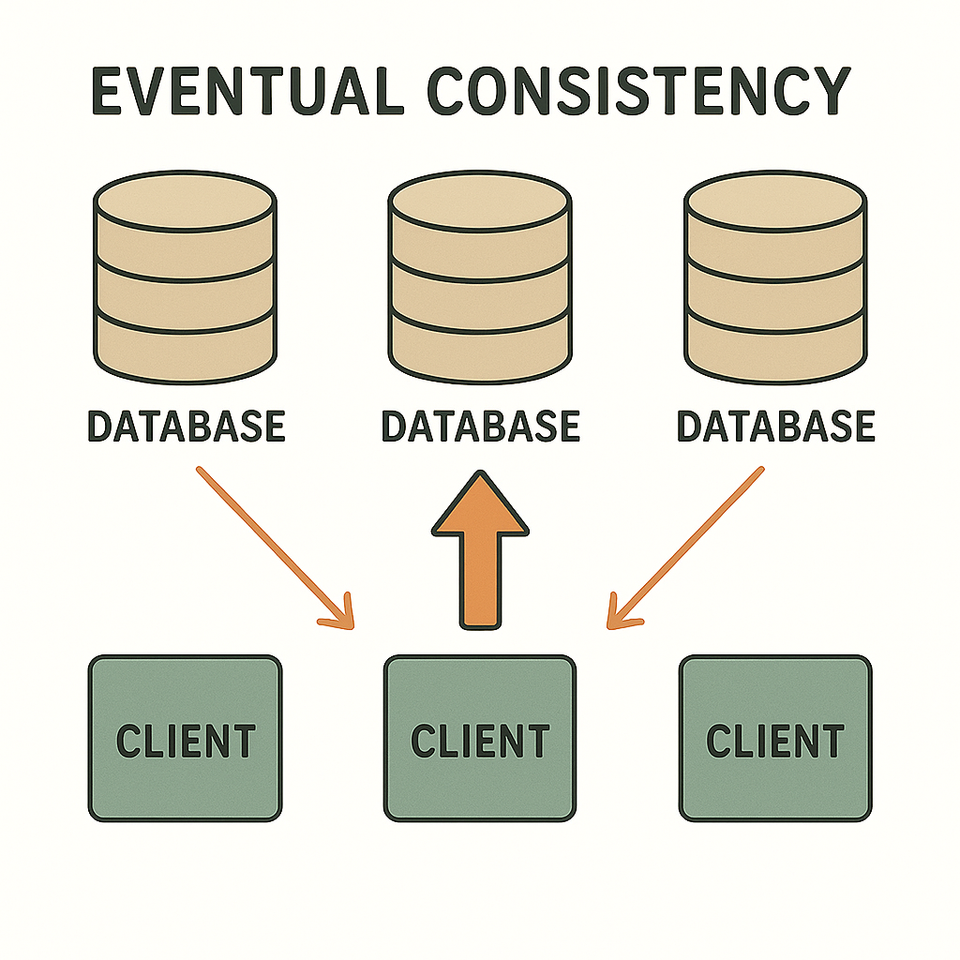A TPM’s Quick Guide to Eventual Consistency

One of the most critical and commonly misunderstood concepts in distributed systems is eventual consistency. While engineers wrestle with implementation details, TPMs must understand what eventual consistency is, when it applies, and how to plan around it.
This guide is your no-nonsense introduction to eventual consistency: what it is, why it matters, and how to manage programs that rely on it.
What Is Eventual Consistency?
Eventual consistency is where all updates to a data system will eventually propagate to all nodes, and all replicas will converge to the same value, given enough time and no new updates.
Put simply: not all nodes see the same data at the same time, but they will, eventually. As opposed to strong consistency*, where all users always see the same data at the same time (as in a traditional relational database with ACID guarantees).
To visualize this, think of updating your profile photo on a social platform. You might see the new photo immediately, but a friend in another geography might still see the old one for a few seconds or minutes. Eventually, the system synchronizes the update across all replicas.
Why Eventual Consistency Exists
Distributed systems are designed to be fault-tolerant, highly available, and scalable. But, as per the CAP Theorem (Brewer’s Theorem), you can only have two out of the following three at any given time:
- Consistency
- Availability
- Partition Tolerance
In real-world distributed systems, partition tolerance is non-negotiable, you can’t prevent network failures. So engineers often have to trade off between consistency and availability.
Eventual consistency favors availability over immediate consistency. This trade-off allows systems to continue operating even when nodes are temporarily unable to communicate.
Where You’ll Encounter It
As a TPM, you’re likely to see eventual consistency show up in programs that use:
- Cloud-native databases like Amazon DynamoDB, Cassandra, Riak
- Event-driven architectures using Kafka, Kinesis, or other pub-sub systems
- Microservices that perform asynchronous updates to shared data
- Geo-distributed systems that replicate data across regions
Understanding eventual consistency helps you grasp why systems may display “weird” behavior, such as:
- Slight delays in data propagation
- Conflicting updates
- Temporarily inconsistent user experiences
The Risks and Realities
Eventual consistency isn’t free. It introduces complexity and can cause problems if not managed correctly. Here are some practical issues you might need to navigate:
1. Stale Reads
A user may read old data while the system is still propagating the latest update. This can lead to confusion or incorrect decisions, especially in transactional or high-stakes scenarios.
Example: An e-commerce inventory system that briefly shows items as available when they’ve already sold out.
2. Write Conflicts
In a multi-master system, concurrent updates can conflict. These must be resolved, either automatically or manually.
Resolution strategies include:
- Last write wins (LWW)
- Merging changes
- Custom application logic
3. User Trust Issues
If a system shows different data in different places (e.g., a dashboard and a notification), users might assume the product is buggy, even if it’s working as designed.
How TPMs Can Navigate Eventual Consistency
You should be fluent in how eventual consistency affects planning, design, and delivery. Here’s how to stay ahead:
1. Align Expectations Early
Ensure that stakeholders, especially product and design understand the implications of eventual consistency. Use real-world analogies and demos to help non-technical audiences grasp potential data lags or delays. Facilitate business decision making as a conduit.
Tip: Work with engineers to define SLAs or “consistency windows” that set expectations for how quickly data should converge.
2. Clarify Data Freshness Requirements
Not all data needs to be perfectly up to date. Work with product owners to identify where consistency matters most. This helps teams choose the right consistency model for each part of the system.
For example:
- A user’s avatar can tolerate lag.
- A financial transaction log cannot.
3. Build for Observability
Encourage teams to instrument systems with metrics that track propagation delays, conflict rates, and data freshness. As a TPM, use these metrics to monitor risk and communicate progress.
Key metrics to ask for:
- Replication lag
- Event processing delay
- Consistency window breaches
4. Test for Consistency Failures
Coordinate with QA and SRE teams to design test cases that simulate network partitions and delayed propagation. These edge cases often only surface in production without targeted testing.
Chaos engineering techniques (like simulating node failures or message delays) can also help uncover latent issues (and an idea for a future article).
5. Plan for Eventual Resolution
In eventual consistency systems, your program timelines might need to include time for asynchronous reconciliation. Whether it’s background jobs catching up or manual data repair, make sure your timelines and retrospectives account for it.
Real-World Tools
Understanding where eventual consistency is used in the real world can make the concept more tangible. Here are a few notable examples:
Amazon DynamoDB
DynamoDB allows eventual consistency by default for faster reads and better availability. Developers can choose strongly consistent reads when necessary.
Twitter’s Tweet Delivery System
Twitter’s timeline infrastructure relies on eventual consistency to propagate tweets across user timelines quickly and at scale. There may be slight delays between when a tweet is posted and when it appears on all timelines, but the system favors speed and availability.
Netflix’s Metadata System
Netflix uses eventual consistency in its distributed metadata system. According to Netflix engineers, this allows them to handle regional failures and maintain availability without strict consistency requirements for most user-facing data.
Final Thoughts
As a TPM, you’re in the business of trade-offs—and eventual consistency is all about balancing them. It may not always be the right fit, but understanding it helps you:
- Set realistic timelines
- Design better user experiences
- Choose the right tooling and architecture
- Align stakeholders and manage risk
At the end of the day, eventual consistency is not a bug. It’s a design choice—one that enables modern systems to operate at global scale.
Because in distributed systems, eventually consistent is often the best kind of consistent you can hope for.





Member discussion